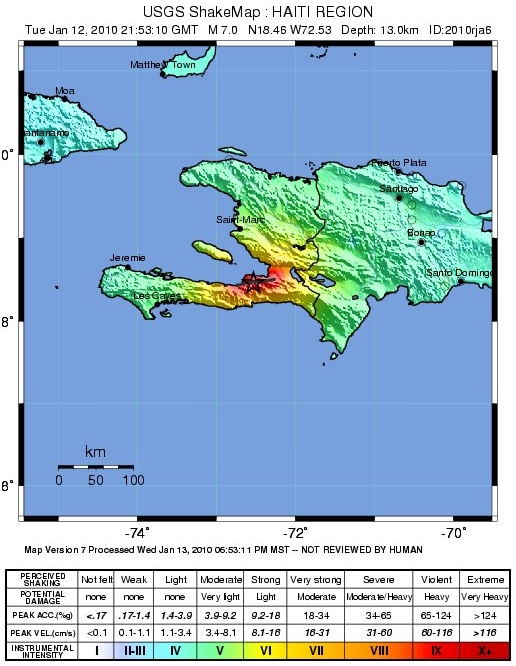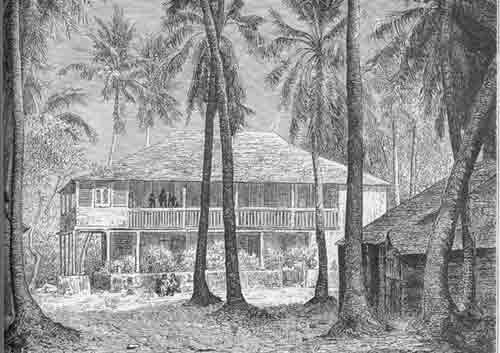|
Désastre (12 Janvier 2010)
''Désastre (12 janvier 2010)'' is an artwork of Haitian artist Frankétienne. This acrylic on canvas was painted between 15 and 16 January 2010, the same week the 2010 earthquake hit Port-au-Prince, Haiti Haiti, officially the Republic of Haiti, is a country on the island of Hispaniola in the Caribbean Sea, east of Cuba and Jamaica, and south of the Bahamas. It occupies the western three-eighths of the island, which it shares with the Dominican ...'s capital city. The artwork represents the victims below the city's wreckage. It was shown to the public for the last time during the exposition "Pour la memoire et la lumière" ("For memory and light") promoted by the foundation Ayiti Bel at the Hotel NH Haiti El Rancho, in Pétion-Ville, Haití, between 11 and 25 April 2014. Later, it was acquired by a private collector. Gallery References 2010 paintings Haitian paintings {{21C-painting-stub ... [...More Info...] [...Related Items...] OR: [Wikipedia] [Google] [Baidu] |
Frankétienne
Jean-Pierre Basilic Dantor Franck Étienne d'Argent (; 12 April 1936 – 20 February 2025), known by his pen name Frankétienne, was a Haitian writer, poet, playwright, and painter. He is recognized as one of Haiti's leading writers and playwrights in both French and Haitian Creole, and is "known as the father of Haitian letters". He was a candidate for the Nobel Prize in Literature in 2009, made a Commander of the ''Ordre des Arts et des Lettres'' (Order of the Arts and Letters), and was named UNESCO Artist for Peace in 2010. Life and career Jean-Pierre Basilic Dantor Franck Étienne d'Argent was born in Ravine-Sèche, a small village in Haiti. His mother, Annette Étienne, a black Haitian, was 16 when she gave birth to him, and his father, Benjamin Lyles, a wealthy white American, was 63. His father then abandoned the family. Frankétienne later said that he was given his first names by his mother and grandmother to protect him from sorcery. He was raised by his mother in the ... [...More Info...] [...Related Items...] OR: [Wikipedia] [Google] [Baidu] |
Acrylic Paint
Acrylic paint is a fast-drying paint made of pigment suspended in acrylic polymer emulsion and plasticizers, silicone oils, defoamers, stabilizers, or metal soaps. Most acrylic paints are water-based, but become water-resistant when dry. Depending on how much the paint is diluted with water, or modified with acrylic gels, mediums, or pastes, the finished acrylic painting can resemble a watercolor, a gouache, or an oil painting, or it may have its own unique characteristics not attainable with other media. Water-based acrylic paints are used as latex house paints, as latex is the technical term for a suspension of polymer microparticles in water. Interior latex house paints tend to be a combination of binder (sometimes acrylic, vinyl, PVA, and others), filler, pigment, and water. Exterior latex house paints may also be a co-polymer blend, but the best exterior water-based paints are 100% acrylic, because of its elasticity and other factors. Vinyl, however, costs half of w ... [...More Info...] [...Related Items...] OR: [Wikipedia] [Google] [Baidu] |
Canvas
Canvas is an extremely durable Plain weave, plain-woven Cloth, fabric used for making sails, tents, Tent#Marquees and larger tents, marquees, backpacks, Shelter (building), shelters, as a Support (art), support for oil painting and for other items for which sturdiness is required, as well as in such fashion objects as handbags, electronic device cases, and shoes. It is popularly used by artists as a painting surface, typically stretched across a wooden frame. Although historically made from hemp, modern canvas is usually made of cotton, linen, or sometimes polyvinyl chloride (PVC). It differs from other heavy cotton fabrics, such as denim, in being plain weave rather than Twill, twill weave. Canvas comes in two basic types: plain and Cotton duck, duck. The threads in duck canvas are more tightly woven. The term ''duck'' comes from the Dutch language, Dutch word for cloth, ''doek''. In the United States, canvas is classified in two ways: by weight (ounces per square yard) and by ... [...More Info...] [...Related Items...] OR: [Wikipedia] [Google] [Baidu] |
2010 Haiti Earthquake
The 2010 Haiti earthquake was a catastrophic Moment magnitude scale, magnitude 7.0 Mw earthquake that struck Haiti at 16:53 local time (21:53 UTC) on Tuesday, 12 January 2010. The epicenter was near the town of Léogâne, Ouest (department), Ouest department, approximately west of Port-au-Prince, Haiti's capital. By 24 January, at least 52 aftershocks measuring 4.5 or greater had been recorded. An estimated three million people were affected by the quake. Death toll estimates range from 100,000 to about 160,000 to Haitian government figures from 220,000 to 316,000, although these latter figures are a matter of some dispute. The earthquake is the deadliest natural disaster of the 21st century for a single country. The government of Haiti estimated that 250,000 residential area, residences and 30,000 commercial buildings had collapsed or were severely damaged. Haiti's history of External debt of Haiti, national debt, prejudicial trade policies by other countries, and for ... [...More Info...] [...Related Items...] OR: [Wikipedia] [Google] [Baidu] |
Port-au-Prince
Port-au-Prince ( ; ; , ) is the Capital city, capital and List of cities in Haiti, most populous city of Haiti. The city's population was estimated at 1,200,000 in 2022 with the metropolitan area estimated at a population of 2,618,894. The metropolitan area is defined by the IHSI as including the Communes of Haiti, communes of Port-au-Prince, Delmas, Ouest, Delmas, Cité Soleil, Tabarre, Carrefour, Ouest, Carrefour, and Pétion-Ville. The city of Port-au-Prince is on the Gulf of Gonâve: the bay on which the city lies, which acts as a natural harbor, has sustained economic activity since the civilizations of the Taíno. It was first incorporated under Saint-Domingue, French colonial rule in 1749. The city's layout is similar to that of an amphitheater; commercial districts are near the water, while residential neighborhoods are located on the hills above. Its population is difficult to ascertain due to the rapid growth of slums in the hillsides above the city; however, recent ... [...More Info...] [...Related Items...] OR: [Wikipedia] [Google] [Baidu] |
Haiti
Haiti, officially the Republic of Haiti, is a country on the island of Hispaniola in the Caribbean Sea, east of Cuba and Jamaica, and south of the Bahamas. It occupies the western three-eighths of the island, which it shares with the Dominican Republic. Haiti is the third largest country in the Caribbean, and with an estimated population of 11.4 million, is the most populous Caribbean country. The capital and largest city is Port-au-Prince. Haiti was originally inhabited by the Taíno people. In 1492, Christopher Columbus established the first European settlement in the Americas, La Navidad, on its northeastern coast. The island was part of the Spanish Empire until 1697, when the western portion was Peace of Ryswick, ceded to France and became Saint-Domingue, dominated by sugarcane sugar plantations in the Caribbean, plantations worked by enslaved Africans. The 1791–1804 Haitian Revolution made Haiti the first sovereign state in the Caribbean, the second republic in the Americ ... [...More Info...] [...Related Items...] OR: [Wikipedia] [Google] [Baidu] |
2010 Paintings
1 (one, unit, unity) is a number, numeral, and glyph. It is the first and smallest positive integer of the infinite sequence of natural numbers. This fundamental property has led to its unique uses in other fields, ranging from science to sports, where it commonly denotes the first, leading, or top thing in a group. 1 is the unit of counting or measurement, a determiner for singular nouns, and a gender-neutral pronoun. Historically, the representation of 1 evolved from ancient Sumerian and Babylonian symbols to the modern Arabic numeral. In mathematics, 1 is the multiplicative identity, meaning that any number multiplied by 1 equals the same number. 1 is by convention not considered a prime number. In digital technology, 1 represents the "on" state in binary code, the foundation of computing. Philosophically, 1 symbolizes the ultimate reality or source of existence in various traditions. In mathematics The number 1 is the first natural number after 0. Each natural number, ... [...More Info...] [...Related Items...] OR: [Wikipedia] [Google] [Baidu] |

